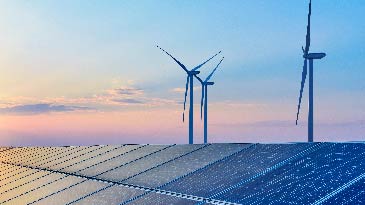Since 2000, global demand for power has increased by more than 70 percent with a significant portion of that increase being fulfilled by renewable sources like wind and solar, now representing nearly a third of all power generation.
Meeting this growing need however hasn’t been as simple as pumping more electricity into existing networks. In many areas the electric grid is already at capacity, meaning adding more power to the system could lead to equipment failures and brownouts. Further complicating matters are the specific challenges—like intermittent generation and frequency regulation—that come with renewable power.
Utilities are expected to provide safe and reliable power by ensuring generation supplies balance with end-consumer load on a minute-by-minute basis. While renewables offer great promise for decarbonization and help the world meet net-zero emissions goals, the intermittent nature of renewable power—wind turbines turn only when the wind blows, and solar panels produce electricity only when the sun shines—creates a significant hurdle. To intelligently integrate renewables into the grid, operators must be able to reliably forecast when and how much electricity they can generate, and what impact it will have on the grid.
Adding complexity to the issue is the proliferation of distributed energy resources (DERs) such as rooftop solar and photovoltaic (PV) technologies, batteries, electric vehicles and smart thermostats among others. This is fundamentally transforming the historically unidirectional flow of power from generation through transmission to distribution. In this environment, utilities are faced with many challenges—and many opportunities—when it comes to the integration and management of these resources at scale in a comprehensive, efficient and reliable manner.
Beyond utilities, asset-intensive industries are increasingly embracing DERs such as onsite renewable power generation and battery storage. This means they are also progressively realizing the challenges and opportunities associated with balancing their own power networks’ inward and outward flows.
To face these challenges while taking hold of the opportunities, companies are increasingly adopting distributed energy resource management systems (DERMS) to enable real-time monitoring, management, control and optimization of all non-traditional energy resources.
Creating a Comprehensive DERMS Solution
Many vendors are offering some form of DERMS software however the reality is that most are relatively limited to managing a single or very few types of DERs. A key feature of any DERMS software is to provide power system operators with the ability to track, understand and in some cases, control the behavior of many and all types of DERs connected to their networks. As such, a comprehensive, enterprise wide DERMS solution must provide:
- Management of all DERs in a single platform through a system of systems approach
- Safe network operations through exhaustive forecasting and optimization of DERs
- Operational flexibility, collaboration, visibility and reporting capabilities for control room and non-control room stakeholders
- Dynamic resource management, including the scheduling and dispatch of resources by device type, location, etc.
- Resource value maximization and market participation capabilities across all DER types
- Secure operations within the control room while fully integrated with real-time control systems
- Complete visibility and awareness of DER behaviors
- Advancement of sustainability goals by maximizing DER usage and quantifying impacts
A properly integrated enterprise DERMS software, such as OSI’s IntegraTM DERMS solution, provides enhanced situational awareness allowing operators to see, in real-time, the devices connected to the network, their location and how they impact demand. This makes it far easier to balance the load and ultimately keep the power on. The resulting enhanced reliability of power ensures companies can focus on serving their customers with more affordable power or goods.
By enabling increased network efficiency, DERMS also allows companies to improve operational costs and extend the life of existing equipment resulting in significant savings in capital investments. DERMS can provide additional value by creating new revenue streams with greater access to wholesale energy markets through the creation and enablement of virtual power plants (VPPs).
Meanwhile, by more effectively making additional non-carbon intensive resources available to network operators, DERMS solutions—along with other digitalization technologies—are playing a key role in supporting the net zero journey and helping to deliver a more sustainable world.
.png?h=250&w=975&la=ru&hash=33793B077F9EE2AF213763DF1A58F8B5)




Leave A Comment